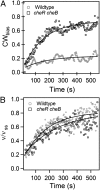Dynamics of mechanosensing in the bacterial flagellar motor
- PMID: 23818629
- PMCID: PMC3718179
- DOI: 10.1073/pnas.1305885110
Dynamics of mechanosensing in the bacterial flagellar motor
Abstract
Mechanosensing by flagella is thought to trigger bacterial swarmer-cell differentiation, an important step in pathogenesis. How flagellar motors sense mechanical stimuli is not known. To study this problem, we suddenly increased the viscous drag on motors by a large factor, from very low loads experienced by motors driving hooks or hooks with short filament stubs, to high loads, experienced by motors driving tethered cells or 1-μm latex beads. From the initial speed (after the load change), we inferred that motors running at very low loads are driven by one or at most two force-generating units. Following the load change, motors gradually adapted by increasing their speeds in a stepwise manner (over a period of a few minutes). Motors initially spun exclusively counterclockwise, but then increased the fraction of time that they spun clockwise over a time span similar to that observed for adaptation in speed. Single-motor total internal reflection fluorescence imaging of YFP-MotB (part of a stator force-generating unit) confirmed that the response to sudden increments in load occurred by the addition of new force-generating units. We estimate that 6-11 force-generating units drive motors at high loads. Wild-type motors and motors locked in the clockwise or counterclockwise state behaved in a similar manner, as did motors in cells deleted for the motor protein gene fliL or for genes in the chemotaxis signaling pathway. Thus, it appears that stators themselves act as dynamic mechanosensors. They change their structure in response to changes in external load. How such changes might impact cellular functions other than motility remains an interesting question.
Keywords: Escherichia coli; mechanical load; stator remodeling.
Conflict of interest statement
The authors declare no conflict of interest.
Figures




References
-
- Engler AJ, Sen S, Sweeney HL, Discher DE. Matrix elasticity directs stem cell lineage specification. Cell. 2006;126(4):677–689. - PubMed
-
- Gebhardt JC, Rief M. Biochemistry. Force signaling in biology. Science. 2009;324(5932):1278–1280. - PubMed
-
- Rather PN. Swarmer cell differentiation in Proteus mirabilis. Environ Microbiol. 2005;7(8):1065–1073. - PubMed
Publication types
MeSH terms
Substances
Grants and funding
LinkOut - more resources
Full Text Sources
Other Literature Sources
Molecular Biology Databases

